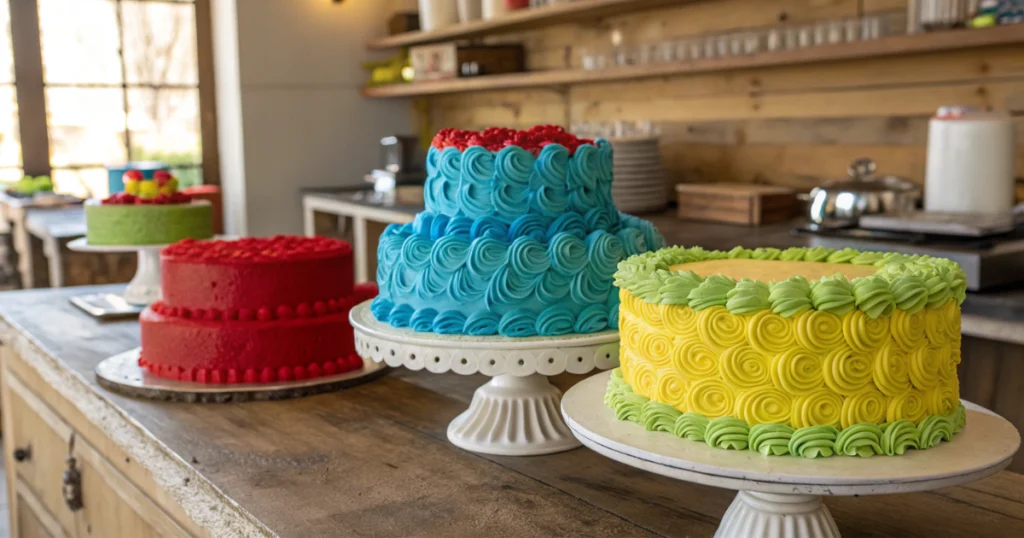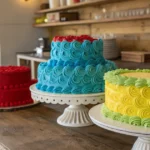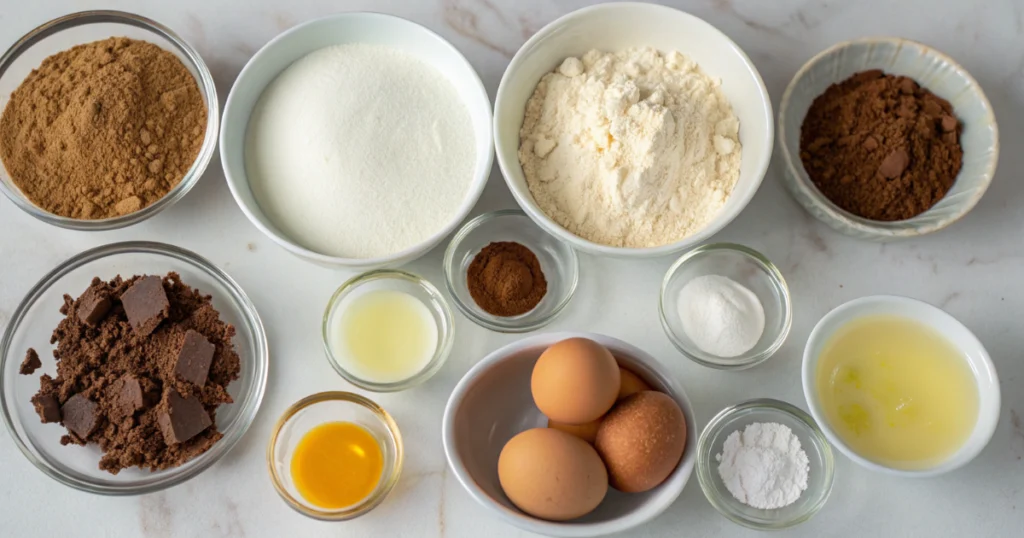20 velvet cake recipes that are tender, rich, and downright delicious—these cakes aren’t just eye-catching, they’re everything a home baker loves. With a smooth crumb and just the right balance of flavor, velvet cakes bring something special to any celebration or weekend treat.

From the beloved red velvet to creative twists like lemon, blue, and caramel velvet, this collection offers something for every craving. Whether you’re baking for a birthday or just because, these easy and tasty velvet cake recipes are sure to become your new go-to favorites.
The cooking doesn’t stop here!
Try delicious recipes like Strawberry Sour Cream Cake and matcha and chocolate — let the flavors keep surprising you.

20 Velvet Cake Recipes You’ll Love Baking Again and Again
- Total Time: 55 minutes
- Yield: 12 slices 1x
- Diet: Vegetarian
Description
A classic, soft red velvet cake with a tender crumb and rich cream cheese frosting. One of the essential recipes in your velvet cake collection.
Ingredients
2 1/2 cups all-purpose flour
2 tbsp cocoa powder
1 tsp baking soda
1/2 tsp salt
1 cup buttermilk
1 tbsp vinegar
1 tsp vanilla extract
1 1/2 cups sugar
1/2 cup vegetable oil
2 eggs
2 tbsp red food coloring
Instructions
1. Preheat oven to 350°F (175°C). Grease and flour two 9-inch round cake pans.
2. In a bowl, sift together flour, cocoa, baking soda, and salt.
3. In another bowl, whisk together buttermilk, vinegar, vanilla, and food coloring.
4. In a large bowl, beat sugar and oil until combined. Add eggs one at a time.
5. Alternate adding the dry and wet ingredients to the sugar mixture. Mix just until combined.
6. Divide batter evenly between pans. Bake for 30–35 minutes or until a toothpick comes out clean.
7. Cool completely before frosting.
Notes
Make sure all ingredients are at room temperature.
Don’t overmix once dry and wet ingredients are combined.
- Prep Time: 20 minutes
- Cook Time: 35 minutes
- Category: Dessert
- Method: Baking
- Cuisine: American
Nutrition
- Serving Size: 1 slice
- Calories: 380
- Sugar: 32g
- Sodium: 320mg
- Fat: 18g
- Saturated Fat: 6g
- Unsaturated Fat: 10g
- Trans Fat: 0g
- Carbohydrates: 48g
- Fiber: 1g
- Protein: 4g
- Cholesterol: 55mg
Table of Contents
Table of Contents
The Story & Intro
20 velvet cake recipes might sound like a lot, but once you taste that soft, melt-in-your-mouth texture, you’ll understand why it’s impossible to stop at just one. My journey with velvet cakes started with the classic red version—rich, slightly tangy, and finished with a silky cream cheese frosting. I baked it on a whim for a family dinner, not expecting much. But after the first slice disappeared in seconds and every plate came back clean, I knew I had something special.
That red velvet cake became a regular request, and I quickly realized the potential of velvet-style cakes. From there, I started branching out—blue velvet for a birthday, lemon velvet for spring, green velvet for fun holiday baking. The smooth, tender crumb and bold colors made each one feel new and exciting. That’s what inspired me to gather these 20 velvet cake recipes into one easy guide.
Velvet cakes stand out because of their texture. They’re soft without being fragile, rich without feeling heavy. The magic comes from simple ingredients: buttermilk, vinegar, and a touch of baking soda. Together, they create a light batter with a fine crumb that holds up beautifully whether you’re making cupcakes, layered cakes, or something in between.
Each recipe in this collection brings something different to the table. Some are timeless, like the original red velvet. Others add playful twists—flavors like caramel, pink raspberry, or even black velvet made with dark cocoa. But they all follow the same basic method, which means once you master one, the rest come easy. That’s part of what makes 20 velvet cake recipes such a great resource—you can mix, match, and experiment without starting from scratch every time.
I’ve baked these cakes for birthdays, holidays, potlucks, and quiet Sundays at home. No matter the occasion, they never fail to impress. And the best part? They’re more approachable than they look. If you’ve got a mixing bowl, a few pantry staples, and a little time, you’ve got everything you need to start baking.
So if you’re ready to add something bold, beautiful, and reliably delicious to your dessert rotation, these 20 velvet cake recipes are ready to meet you in the kitchen.
Want to discover more?
Don’t miss out on recipes like kidney patient eat for dinner? or Strawberry Sour Cream Cake — they’re easy, tasty, and tested in real kitchens.
Essential Tips Before You Bake
There’s no better way to make your 20 velvet cake recipes shine than starting with the right techniques. Velvet cakes aren’t difficult, but a few key tips can make the difference between “just okay” and absolutely bakery-worthy. The ingredients matter, but how you use them matters even more. Let’s break it down so you can bake every version with confidence.
Mastering Moisture and Texture
If you’ve ever had a dry velvet cake, chances are something was off with the basics. The good news? Moist, fluffy velvet cake starts with common ingredients and simple steps. Buttermilk adds tang and tenderness. Vinegar reacts with baking soda to help the cake rise evenly. Oil (instead of butter) keeps the crumb soft, even after
The Best 20 Velvet Cake Recipes
Velvet cakes are loved for their tender crumb, eye-catching colors, and just the right amount of richness. This selection of 20 velvet cake recipes brings together dependable classics and creative twists that work beautifully for birthdays, holidays, or any day you want something sweet and special. Each recipe is designed to be approachable and rewarding, no matter your baking experience.

Classic & Colorful Velvet Cakes
Start with the flavors that made velvet cakes famous. These options are simple to bake and consistently deliver that signature soft, smooth texture:
- Red Velvet Cake – Lightly cocoa-flavored with a gentle tang, finished with cream cheese frosting.
- Blue Velvet Cake – A bold visual twist that’s just as soft and satisfying.
- White Velvet Cake – Vanilla-forward and delicate, perfect for layered celebrations.
- Black Velvet Cake – Dark, rich, and elegant with extra cocoa depth.
- Green Velvet Cake – Fun and festive for spring holidays or anytime you want something unexpected.
- Pink Velvet Cake – Sweet and charming, with a soft rose tint.
- Lemon Velvet Cake – Bright and citrusy, balanced by the creamy crumb.
- Caramel Velvet Cake – Buttery and rich, offering a deeper sweetness.
- Purple Velvet Cake – Playful and perfect for themed events.
- Orange Velvet Cake – A zesty, vibrant spin on a familiar favorite.
These ten recipes are the heart of the collection, showing off the full range of what velvet cakes can be—without losing the comforting texture that ties them all together.
Creative Twists and Modern Favorites
The second half of these 20 velvet cake recipes leans into fun, flexible ideas you can mix and match depending on the season or occasion:
- Red Velvet Cheesecake Cake – Layers of red velvet and tangy cheesecake in one showstopper dessert.
- Velvet Sheet Cake – Simple, sliceable, and ideal for feeding a crowd.
- Velvet Cupcakes Sampler – Mini versions of your favorite colors and flavors.
- Gluten-Free Velvet Cake – Soft and flavorful without traditional flour.
- Vegan Red Velvet Cake – Dairy-free and still completely delicious.
- Marble Velvet Cake – A swirl of color and cocoa in every bite.
- Velvet Cake Pops – Easy to grab, fun to decorate, and kid-approved.
- Layered Velvet Icebox Cake – No oven required, just layers of chilled goodness.
- Holiday Velvet Cake Roll – Rolled up with frosting and ready to slice.
- Naked Velvet Wedding Cake – Beautiful in its simplicity and perfect for special occasions.
These recipes show just how versatile velvet cake can be. Whether you’re sticking to tradition or adding a twist, these 20 velvet cake recipes make baking feel creative and fun every time.our own.
Pro Secrets & Serving Suggestions
Once you’ve chosen a few favorites from your list of 20 velvet cake recipes, a few smart tips can help you bake them better, serve them with style, and avoid common mistakes. Velvet cakes are known for their texture and flavor, but what takes them to the next level is how you finish and present them.
The Vinegar Question: Why It Matters
One of the most unexpected ingredients in many velvet cakes is vinegar. It might seem unusual to add something acidic to a dessert, but it’s a key part of what makes these cakes stand out. When mixed with baking soda, vinegar causes the batter to rise gently, which gives the cake its signature soft crumb.
In recipes like red velvet, vinegar also enhances the color by interacting with cocoa powder and food coloring. Even in non-cocoa versions like lemon or white velvet, a little vinegar still plays a behind-the-scenes role in helping the cake stay moist and airy.
Best of all, you won’t taste it. The vinegar blends into the batter and disappears during baking, leaving you with nothing but smooth texture and a light, balanced flavor.
Frosting, Finishing & Serving Like a Pro
Velvet cakes are wonderfully versatile when it comes to frosting. Red velvet pairs naturally with cream cheese frosting, but other versions like lemon or caramel work beautifully with whipped buttercream, mascarpone, or citrus glazes. The key is choosing a frosting that complements rather than overwhelms the cake’s delicate texture.
If you’re making a layer cake, aim for smooth, even layers of frosting between each tier. For a more rustic look, try a “naked” finish where the sides remain partially visible. A dusting of powdered sugar or a few fresh berries can also add a nice touch without complicating things.
Storage matters too. Most cakes will keep well at room temperature for a day or two, as long as they don’t include perishable fillings. Cakes made with cream cheese or fresh fruit should be refrigerated. Before serving, bring them back to room temperature to restore their soft, velvety feel.
These finishing steps help every recipe in your collection feel polished and celebration-ready. No matter which flavors you try first, the best part about these 20 velvet cake recipes is how easy they are to personalize—and how reliably delicious they turn out every time.
Conclusion
Velvet cakes have a way of standing out—whether it’s the smooth crumb, rich flavor, or vibrant colors that catch the eye. They’re versatile, festive, and surprisingly simple to make once you understand the basics. With these 20 velvet cake recipes, you’ve got options for every occasion, every flavor preference, and every skill level. From bold classics to fun, creative twists, each recipe offers something to love.
The origins of red velvet cake date back to the early 20th century, with many linking its popularity to the American South and its appearance in vintage cookbooks and diner menus. That iconic red color, paired with tangy cream cheese frosting, turned it into a nostalgic favorite. But what started with red velvet has grown into a full rainbow of velvet cake varieties, each one offering its own take on texture and flavor.
These days, you’ll find velvet cakes not just in bakeries but on cooking shows, food blogs, and even in historical write-ups like those on Wikipedia’s Red Velvet Cake page. They’ve become part of baking culture—celebrated for being both accessible and stunning. And with this collection, you can bring that same appeal into your own kitchen.
For more recipes follow me in facebook and pinterest
and medium
FAQ
What’s the difference between a velvet cake and a regular cake?
Velvet cakes use a mix of buttermilk, vinegar, and baking soda, which creates a finer, softer crumb than most traditional cakes. Regular cakes often rely on butter and baking powder, resulting in a denser or more open texture. Velvet cakes also tend to have a smooth, melt-in-your-mouth feel that sets them apart.
What makes red velvet cake moist and fluffy?
It’s all about the ingredients working together. Buttermilk and oil keep the cake moist, while vinegar and baking soda help it rise with a light, tender crumb. Proper mixing technique and not overbaking are also key to keeping red velvet soft and airy.
Is velvet cake just chocolate cake but red?
Not quite. Red velvet does contain a small amount of cocoa, but it’s much milder than chocolate cake. The flavor is more balanced, with a slight tang from the buttermilk and vinegar. The color comes from food coloring and natural reactions in the batter—not from being a true chocolate cake.
Why do people add vinegar to red velvet cake?
Vinegar reacts with baking soda to create bubbles that help the cake rise gently, making the crumb soft and fine. It also enhances the cake’s color when used with cocoa powder. You won’t taste the vinegar in the final product—it simply works behind the scenes.
